The Battle of Green Bezel Rolex Submariner, Kermit 16610LV vs. Starbucks 126610LV
So close and yet so different... We compare two generations of black dial/green bezel Submariner watches.

Rolex… Whether you like the brand or not, whether you appreciate its watches or not, whether you understand the hype or not, it is hard to objectively deny the sheer quality and aura of its timepieces. There are obvious reasons for its success, for it to be the number one Swiss watch brand. And then comes the Submariner, probably the most iconic Rolex and one of (if not) the most famous dive watch around, not to mention the green version of this cult model. Today, since the opportunity came to us, we decided to compare two of the most celebrated versions of the Rolex Submariner, both with a green bezel and a black dial, both highly familiar and close to identical, and yet so different. Let’s compare the Kermit 16610LV and the Starbucks 126610LV.
Probably one of the main factors of Rolex’s success lies in its evolutionary strategy in product development. Nothing has to be drastically changed just for the sake of changing. Everything is the result of a continuous improvement of its timepieces, bringing better quality, stronger materials, more comfort, superior functionality or enhanced accuracy, but always with the same, highly recognizable design. Evolution, not revolution. The best way to understand this is by looking at two different watches, separated not by one but two generations.
One was first launched in 2003, the other was released in 2020. And yet, from a distance, they look almost identical. Up until you have a closer inspection at each watch and place them on the wrist. Then you understand how different they are. And that’s what we’re looking at today by comparing two of the most emblematic modern Rolex Submariner models, both green bezel watches with black dials (yes, the full-green Hulk was deliberately omitted here). It’s time for a face-to-face between the neo-vintage Submariner Kermit 16610LV and the contemporary Submariner Starbucks 126610LV.
The first-ever green Submariner, the Kermit 16610LV
It took 50 years for Rolex to introduce its signature green colour to the Submariner collection. 50 years, as a celebration of half a century of the most emblematic watch in its entire portfolio. Launched in 2003 at the Baselworld watch fair, the Rolex Submariner 16610LV (later nicknamed Kermit) was a special edition model – not a limited edition – celebrating the 50th anniversary of the collection. The main difference was, of course, its green insert on the bezel. But that’s not all, as the 16610LV (Lunette Verte, green bezel) introduced other minor changes, compared to all other Submariner models available at that time, including a revised dial with enlarged applied markers and beefed-up hands, later referred to as the “Maxi Dial.”

For the rest, the Rolex Submariner Kermit 16610LV uses the same technical base as a black Submariner Date (16610LN), with a 40mm 904L steel case, a 300m water-resistance, a sapphire crystal with cyclops, an automatic calibre 3135 inside and an Oyster bracelet with solid end-links (ref. 93250) and a folded-steel clasp.
However, this is the general side of things and more than one version of Submariner Kermit 16610LV exists. Over its entire lifespan (2003-2010), the Kermit has reportedly been equipped with 2 different cases (with or without engraved inner flange), 5 different bezel inserts (with Flat 4, with Slim 4, with or without Serif, and in different tones of green), and 5 different dial variations. We’re here talking about minimal evolutions that some have decided to be of importance for the value of certain references on the second-hand market, but we’re not here to debate these details – which would require an entire in-depth article.
The current green/black Submariner, the Starbucks 126610LV
Before the Submariner Starbucks 126610LV existed, the Kermit 16610LV was replaced by another watch, the Submariner Hulk 116610LV. In 2008, Rolex introduced a brand new generation of Submariner (the 6-digit gen), for the first time equipped with a ceramic bezel insert (so-called Cerachrom), all featuring the Maxi Dial concept of the Kermit (large markers/hands). First presented in gold and Rolesor, in 2010 Rolex introduced the 116610LN and 116610LV, respectively the date Submariner with black bezel, and the direct successor to the Kermit, the Hulk. Featuring the new Maxi Case (large shoulders and lugs), it not only came with a green ceramic bezel but also a sunray-brushed green dial.

Fast forward to 2020, and Rolex entirely updated its Submariner collection, this time without a gradual introduction but all references at once. And this range included a new green steel Submariner Date, the 126610LV, which immediately gained the nickname Starbucks (we’ve also heard Cermit, as a contraction of Kermit and Ceramic, but it’s less commonly used). Besides a redefined design, getting rid of the Maxi Case, a new generation of movement (calibre 3235), a redesigned bracelet and moderately updated proportions, the Starbucks 126610LV saw the return of the combination of a green bezel with a black dial, becoming somehow the spiritual successor to the 2003 Kermit.
There are two generations of Submariner Date 126610LV Starbucks, differentiated by their bezel inserts. The first one (MK1), as you can see illustrating this article, features a rather subtle and darker tone of green ceramic. In 2023, Rolex discreetly updated the 126610LV with a new bezel ceramic insert in a brighter, more saturated tone of green (closer to the original Kermit), becoming the so-called MK2.
Overall appearance
I will certainly sound predictable here, but from a certain distance and for people who are not into watches (my mother, most of your friends…) these two watches are both Rolex sports models with a green bezel and look alike. And I can’t prove them wrong, the Kermit 16610LV and Starbucks 126610LV are very close when looked at quickly and from a certain distance. Of course, if you are here reading MONOCHROME, it means that you have more advanced knowledge of watches than the average person, and you will spot notable differences.
Still, it’s rather fascinating how close these two models are, despite being based on architectures separated by more than 30 years (the 16610LN was presented in 1988), and even more if you consider the first 5-digit Submariner references. A Submariner, whatever the generation, is a Submariner and is recognisable in milliseconds. In both watches, design, specifications, overall proportions, dial elements, colours… It’s all very close and yet, as we’ll explore in a bit, there are major differences that are more than just numbers on a specs sheet. It has a lot to do with how these watches feel. It’s like looking at the timeline of the Porsche 911… Show a non-petrolhead a 997 and a 991 and they’ll tell you that, apart from minor design tweaks, these are the same. Car guys know that it goes deeper than that. The same goes for different generations of Submariner watches.
Cases and proportions
As closely related as these two might be, there are important differences to be seen. But we need to go into the fine details of each model to underline the evolution. At first sight, the 16610LV and the 126610LV retain the formula that made the Submariner possibly the most emblematic dive watch on the market. While the design of the collection took a while to settle down, with the first generations feeling today rather different from the current lineup, the introduction of the references 5512 and 5513 in the late 1950s and early 1960s somehow carved the overall design in stone. From there, disregarding the evolution of materials and minor design details, the overall shape of the Submariner hardly changed – this incredible longevity and continuity in the formula is both the reason for the success of the model and also why some tend to reject it…
The Submariner Kermit 16610LV feels to me like the perfect example of a neo-vintage or youngtimer watch, in the sense that it combines the design and overall feel of previous generations while incorporating modern elements such as sapphire crystal and more luxurious dials. The case, here made of 904L stainless steel, is water-resistant to 300m and retains the classic thin lugs and pointy/thin crown guards of older models, as well as an aluminium bezel. It is topped by a flat sapphire crystal with a cyclops over the date (the latter being the only element featuring AR coating). The profile is rather thin, with a slender mid-case and a more pronounced domed profile for the caseback.
The Submariner Starbucks 126610LV does not feel highly different at first sight. A closer inspection reveals, however, important differences. First of all, it’s a more robust watch overall. It feels (and is) slightly bulkier, despite not being much bigger in proportions. Everything in the Starbucks screams modern Rolex and deliberate choices of long-lasting materials. Still made of 904L steel, still water-resistant to 300m, the case has a more “squarish” look, but slightly less pronounced than it was on the previous Hulk model. The reason for that is that Rolex shaved the inner side of the lugs, expanding the width of the bracelet, resulting somehow in a comeback of a more old-school look.
You can see that the case, despite having that typical Rolex Submariner look to it, has changed over the years, with slightly higher side walls, and larger, more rounded crown guards. The caseback is still domed but slightly less than it used to be. Of course, the bezel now incorporates a ceramic insert and the sapphire crystal features an anti-reflective coating. Both are equipped with screw-down crowns, using the Triplock system. Being an older watch that has been used, the Kermit has a slightly less firm and less precise action in the crown, but that is probably down the its age more than the mechanics (even though the machining tolerances have been refined over time).
Side by side, the Starbucks 126610LV feels substantially larger and bulkier than the Kermit 16610LV. Yet, looking at the measurements we’ve done, which are reported above in the chart, the increase in size is marginal – half a millimetre in diameter, 0.2mm in thickness, and half a millimetre in length. What changes most is the width of the bracelet, giving the feeling of a more robust watch – something that the weight only confirms, with about 20 grams more for the 126610LV. Surprisingly, the dial of the Kermit 16610LV tends to visually feel wider than the one on the Starbucks, while being slightly smaller in reality. But this impression is the result of a wider bezel on the current generation.
The bezel – aluminium vs. ceramic
We’re now looking at the main visual difference between these two green Submariner watches, the bezel. Anodized aluminium on one side, with a metallic green colour. Ceramic with an engraved scale coated with PVD platinum, and a uniform colour on the other side. Both are fairly similar in shape and style, with a 60-minute scale and a detailed 0-15 section with smaller minute markers, a triangle marking the zero and a luminous pearl at 12 o’clock. Of course, both watches have a unidirectional rotation (counterclockwise) and 120 clicks.
Yet, when handling these two watches together, you feel the drastic evolution between aluminium and ceramic, but also the overall precision of the clicks when rotating the bezel. There is an undeniable sense of quality, precision and robustness in the Starbucks 126610LV that the Kermit 16610LV simply can’t match. There’s nothing wrong with the latter but the new model is simply superior – it feels like a finely engineered device that will last, with a neat, firm and reassuring lock when rotating the bezel, and yet a very smooth operation. There’s more play, and less firmness in the bezel of the Kermit (again, it might also be due to its age). This goes in line with Rolex’s constant improvement of quality and durability, which also explains the move from aluminium to ceramic.
But what strikes me most isn’t the specifications and technical side, it is how different these two inserts look. I’m not here to judge if one looks better than the other – some will prefer the charm of aluminium, others the modern feel and durability of the Cerachrom insert (I personally like both, for different reasons). Yet, visually, the look of the old Kermit 16610LV is drastically different from the modern Starbucks 126610LV. One has a strong metallic sheen and a more pronounced colour, while the second is glossy, uniform and less saturated (despite the recent 126610LV having a stronger green vibe).
Fairly identical dials
This is probably where both watches feel the most closely related. As explained, the Rolex Submariner Kermit 16610LV introduced to the collection the concept of the Maxi Dial, with oversized hour markers, which became the norm for all Submariners as of the 6-digit generation (from 2008 onwards). Both the Kermit and the Starbucks have glossy black dials with identical literature – Coronet, Rolex and Oyster Perpetual Date at 12 o’clock; Submariner, depth rating (ft – m) and chronometer mention at 6 o’clock – yet with evolutions regarding the size and style of the font.
On both models, the hour markers are applied white gold elements and the hands are oversized versions (once again, something that was first seen on the Submariner Kermit 16610LV in 2003). While the overall design is identical, minor differences can be seen to remain consistent with the evolution of diameter and movement. The main difference lies in the luminescent material. All Kermit 16610LV feature green-emitting Super-LumiNova, while the Submariner Starbucks 126610LV, like all modern Rolex watches, rely on the Chromalight display with long-lasting, blue-emitting proprietary luminescent material. It has to be noted that if SLN tends to shine brighter at first, it fades away more rapidly than the Chromalight display, which shines slightly less but lasts far longer. But overall, these minor evolutions aside, both the 16610LV and the 126610LV have familiar dials.
Calibre 3135 vs. 3235
Together with the different materials for the bezel, the other highly important difference between these two generations of green Submariners lies in what’s hidden inside, the movement. The Kermit 16610LV is powered by one of the most revered movements ever created by Rolex, the long-lasting calibre 3135, itself an evolution of the 3035 (1977-1988). The 3135 has been at the heart of all Submariner Date models from 1988 up until 2020. The Submariner Starbucks 126610LV is powered by a new generation of calibre, the 3235 (first seen in 2016 in the Datejust 41), which introduced major updates to the entire architecture, to the kinetic chain and the escapement, introducing the optimized Chronergy escapement.
The Calibre 3135 is known as one of the most reliable and enduring movements of its time. Measuring 28.5mm, like most Rolex base calibres, it beats at 4Hz, has a bi-directional automatic mechanism, 48 hours of power reserve and is regulated by a classic Swiss lever escapement with a Glucydur balance with Microstella adjusting nuts. It has existed with either a Nivarox or a blue Parachrom hairspring (which was gradually implemented as of 2008-2009). It is chronometer-certified by the COSC.
The Calibre 3235 marked a strong evolution of the classic time-and-date movement at Rolex, with the introduction of a highly revised architecture. The most important element is the Chronergy escapement, with an optimized geometry, offering better chronometric results and improved energy consumption. Together with an updated mainspring, the 3235 offers a generous 70h power reserve. It is equipped with a blue Parachrom hairspring, a Paramagnetic balance with Microstella nuts and a Paraflex antishock system. It retains the 28.5mm diameter dear to the brand, a 4Hz frequency, a bi-directional rotor (now with ball bearings) and the same jewel count (31 in both cases). It is, however, chronometer-certified by the COSC and then internally regulated to run within a -2/+2 seconds/day frame.
Bracelets and clasp
In the same vein as the evolution of the material used for the bezel, the bracelets used by Rolex have evolved over the years. But here, seeing the Kermit and the Starbucks one next to another, you can feel how massive the differences are, specifically when looking at the clasps. Of course, both models are equipped with an Oyster bracelet made of 904L steel. The Kermit relies on the reference 93250, while the Starbucks uses the reference 97JB00. Both are brushed on flat surfaces and polished on the sides, and their length can be adjusted thanks to screws.
The Kermit 16610LV was equipped with solid end-links. The clasp, however, feels from a different era, being made from folded steel all around. It doesn’t feature yet a tool-free micro-adjustment but features a series of holes (4 positions) to adjust the length of the bracelet – but it requires a tool and a bit of patience. There is, however, a wetsuit extension inside the clasp. In full honesty, it is the element of the watch that feels the less robust. This clasp isn’t objectively bad and securely closes, but it doesn’t stand the comparison with modern Rolex clasps. It is, however, fairly comfortable and light, and has a charming look. It is also slightly more compact and thinner (16.7mm in width), even though already quite long.
The green Submariner Date 126610LV, however, features one of the best clasps on the market today, the now-famous Oysterlock folding clasp. A milled piece of metal, it is solid and as robust as the rest of the watch. It is equipped with the Glidelock extension system that allows a quick adjustment of the bracelet’s length without a tool (no Fliplock extension on the Submariner, however). It is composed of a rack and a toothed sliding link, with 10 notches of about 2mm each. This micro-adjustment system adds to the comfort of the watch. The rest of the bracelet is classic Oyster, with a rather large lug width (a bit under 21mm) and an equally wide clasp (about 18.7mm). The clasp is also fairly long but curved enough to hug the wrist. The overall feeling is that of a very finely crafted object that is robust, practical and well-engineered. Side by side, you can truly see the evolution.
On the wrist
As shown above, the difference in size between a Submariner Kermit 16610LV and a Starbucks 126610LV is rather marginal, yet there’s an undeniable difference in weight. Both are very comfortable and remain reasonably sized for such potent dive watches and can easily be worn even on smaller wrists – for reference, both watches are photographed on my 16.5cm wrist.
The difference in weight – approximately 20 grams more for the modern Submariner – does not feel much once on the wrist. This is mostly due to the better distribution of the weight on the newer version, thanks to a heavier clasp balancing the hefty watch head. Also, the wider bracelet plays a role in the fine ergonomics of the modern version. The 126610LV is, despite its size and weight, a watch that you simply wear without thinking about it.
The real difference between these two generations of green Submariner is hardly quantifiable. There are obvious evolutions and differences, which we’ve detailed above, but it goes deeper than facts. There is a true difference in philosophy, perception and visual appeal… They look almost identical but wear incredibly different. It’s the same impression that you’ll get if you jump from a 2005 Range Rover to a 2024 example. One will bring an old-fashioned charm, a certain engine rumble and an analogue feel that the modern one, with all its obvious qualities, won’t have. The new one will, objectively, be better on most quantifiable levels – comfort, performance, economy, safety… But some elements can’t be measured by numbers, and that’s the emotional side of things. The same will happen if you jump from a 2006 Porsche 911-997 into a 2024 Porsche 911-992.
Moving from a Kermit to a Starbucks is the same story. The 126610LV is, on almost all possible quantifiable levels, a much better watch. It is more robust, more tightly constructed, more accurate, features a better clasp, and is extremely detailed and precisely executed. There are, however, emotional considerations that can’t be measured with the Kermit 16610LV… The oddly pleasant rattle of the bracelet, the unique, old-school charm of the aluminium bezel, and the visually more compact and thinner case. The new one is colder and more technical, while the old one manages to make the best out of its flaws, becoming the impalpable reason for what we call charm.
As said, so close yet so different. And indeed, I have taken great satisfaction in wearing both watches, but not for the same reasons, not with the same pleasures.

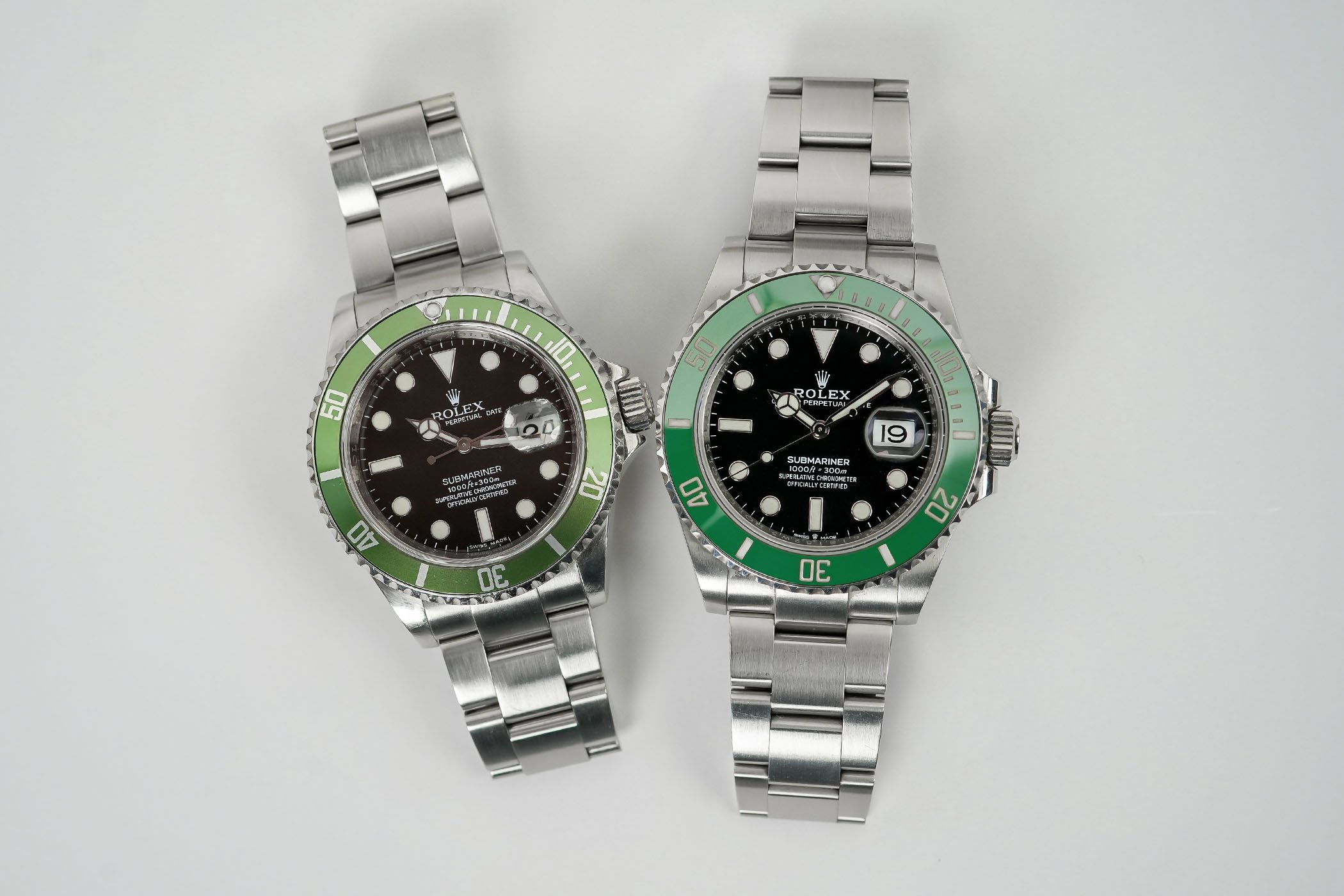


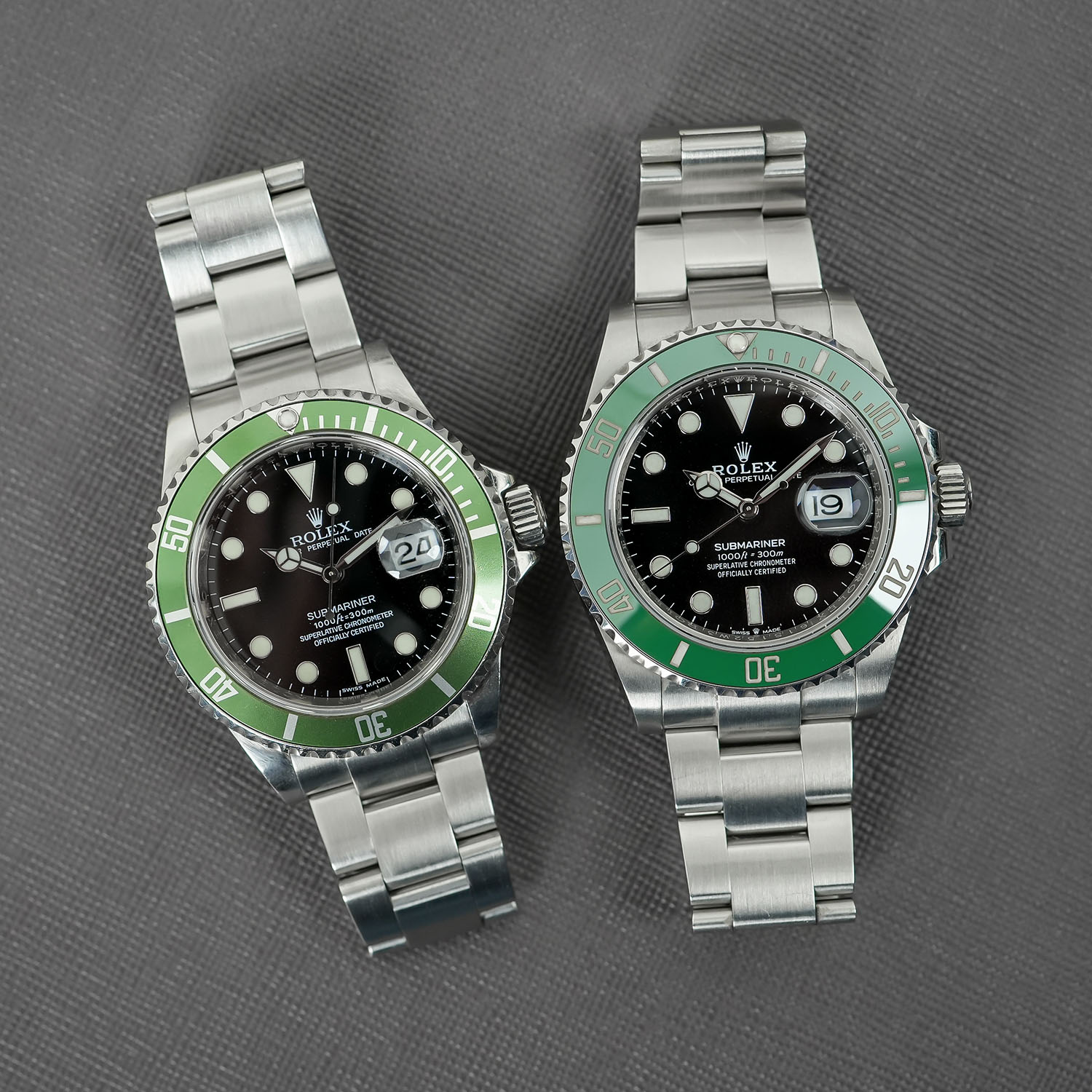



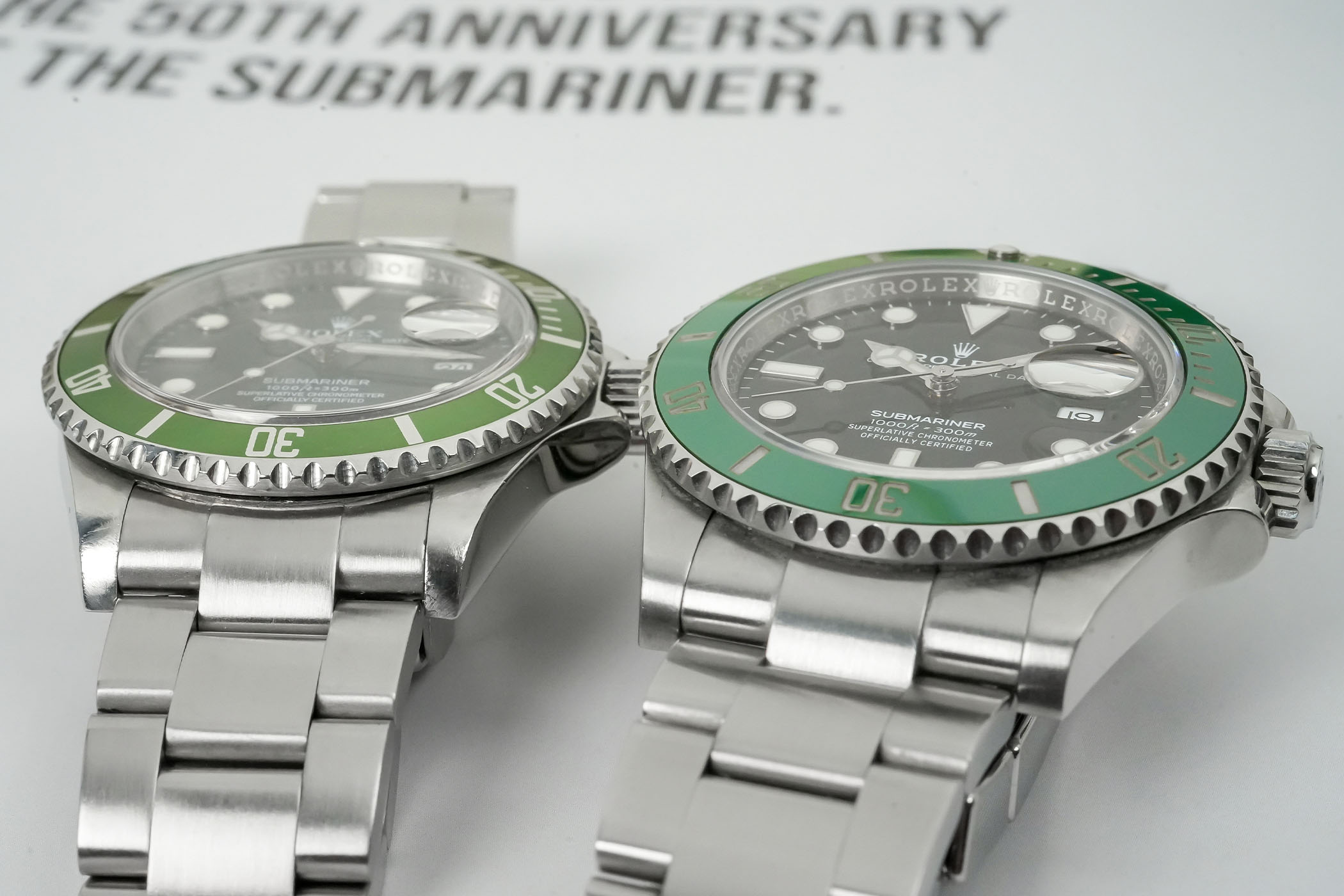




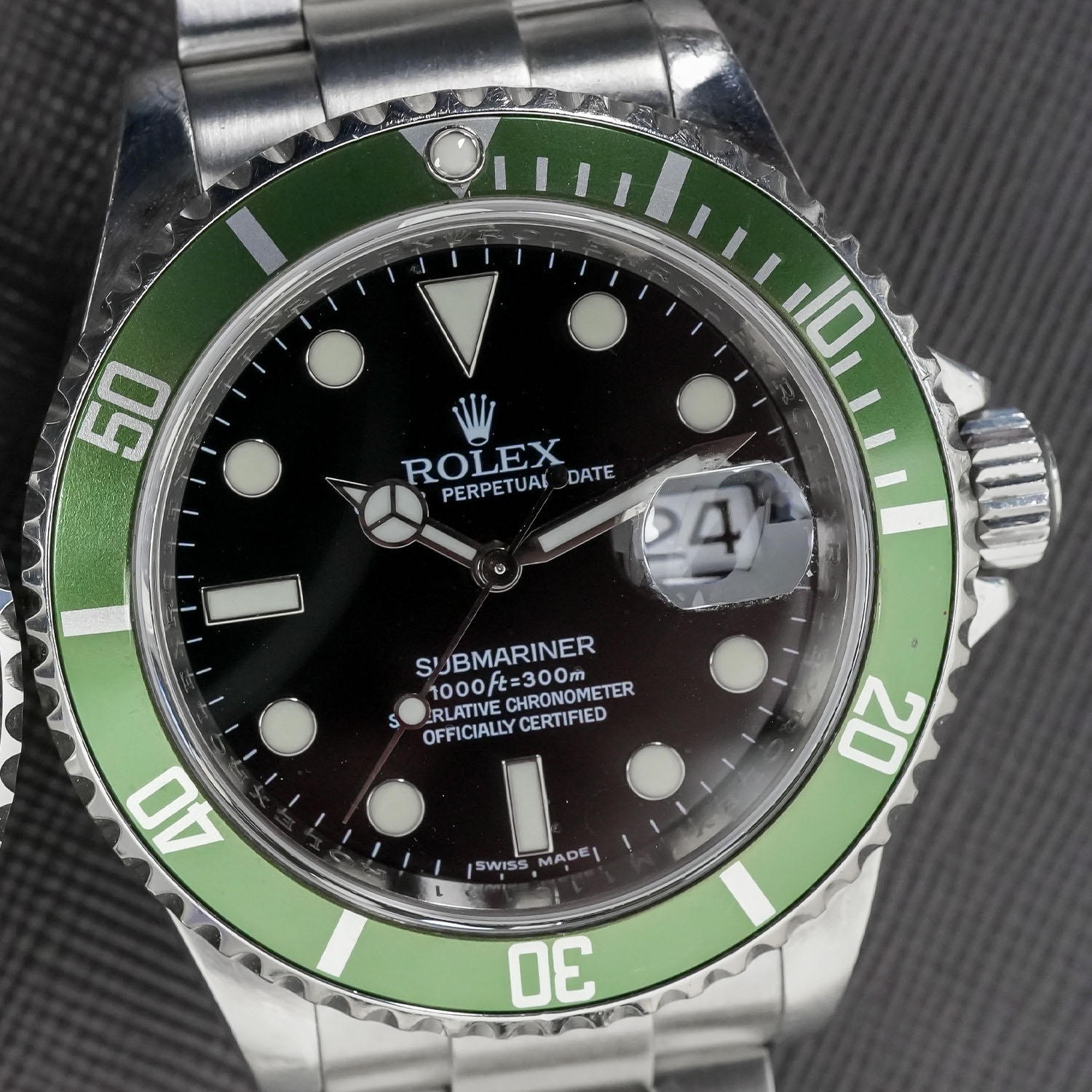

















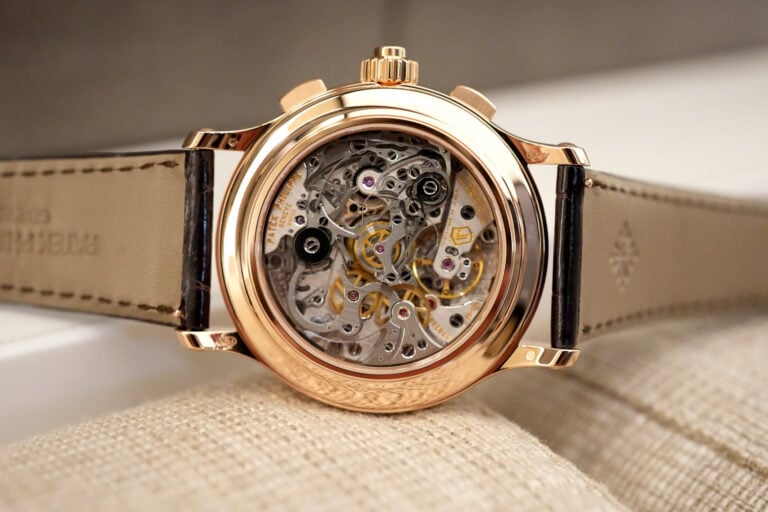
4 responses
This is a superb article, especially for someone who loves Rolex so much, I have the Kermit, the hulk and the Cermit MK2, I didn’t want the MK1 cause I think it didn’t look good, the MK2 looks really like the Kermit but modern, there are few pics here in this piece that I thought the Kermit is a Cermit.MK2, as to how much Rolex nailed the new green. also the new 12 series is utterly comfortable on the wrist.
To me, it’s just a new version of the sae watch.
Unfortunately still wary of the 32XX movements and their infamous amplitude issues. So much so that I sold my 124060 and opted for a 14060 instead. Luckily the smaller sizing works out for my wrist
Wonderfully detailed comparison. As a man with a fairly slim wrist, the smaller of the two (Kermit) would be my choice. Besides, I prefer the slim, neo-vintage look.